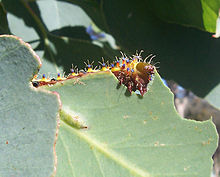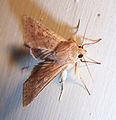This is an old revision of this page, as edited by Betacommand (talk | contribs) at 17:34, 21 March 2007 (removing inappropriate link per WP:EL, WP:SPAM, WP:RS, and WP:NOT). The present address (URL) is a permanent link to this revision, which may differ significantly from the current revision.
Revision as of 17:34, 21 March 2007 by Betacommand (talk | contribs) (removing inappropriate link per WP:EL, WP:SPAM, WP:RS, and WP:NOT)(diff) ← Previous revision | Latest revision (diff) | Newer revision → (diff) For the town in India, see Moth (town).
| Moths | |
|---|---|

| |
| Emperor Gum Moth, Opodiphthera eucalypti | |
| Scientific classification | |
| Kingdom: | Animalia |
| Phylum: | Arthropoda |
| Class: | Insecta |
| Order: | Lepidoptera |
A moth is an insect closely related to the butterfly. Both are of the order Lepidoptera. The division of Lepidopterans into moths and butterflies is a popular taxonomy, not a scientific one. Sometimes the names "Rhopalocera" (butterflies) and "Heterocera" (moths) are used to formalize the popular distinction. Many attempts have been made to subdivide the Lepidoptera into groups such as the Microlepidoptera and Macrolepidoptera, Frenatae and Jugatae, or Monotrysia and Ditrysia. Failure of these names to persist in modern classifications is due to the fact none of them represents a pair of "monophyletic groups". The reality is that butterflies are a small group that arose from within the "moths," and there is thus no way to group all of the remaining taxa in a monophyletic group, as it will always exclude that one descendant lineage.
Most species of moth are nocturnal, but there are crepuscular and diurnal species. They can be distinguished from butterflies in several ways.
People who study butterflies and/or moths are called lepidopterists; the study of butterflies is known as butterflying, and the study of moths mothing, the latter giving rise to the term "mother" for someone who takes part in this activity—sometimes written with a hyphen inserted (moth-er) to distinguish it from the word for a female parent. This confusion does not arise in spoken English since the two terms are pronounced differently.
Etymology
The Modern English word "Moth" comes from Old English "moððe" (cf. Northumbrian "mohðe") from Common Germanic (compare Old Norse "motti", Dutch "Mot" and German "Motte" all meaning "moth"), perhaps its origins are related to Old English "maða" meaning "maggot" or from the root of "midge" which until the 16th century was used mostly to indicate the larva, usually in reference to devouring clothes.
Economic significance of moths

Moths, and particularly their caterpillars, are a major agricultural pest in many parts of the world. The caterpillar of the gypsy moth (Lymantria dispar) causes severe damage to forests in the northeast United States, where it is an invasive species. In temperate climates, the codling moth causes extensive damage, especially to fruit farms. In tropical and subtropical climates, the diamondback moth (Plutella xylostella) is perhaps the most serious pest of brassicaceous crops.
Several moths in the family Tineidae are commonly regarded as pests because their larvae eat fabric such as clothes and blankets made from natural proteinaceous fibers such as wool or silk. They are less likely to eat mixed materials containing artificial fibers. There are some reports that they can be repelled by the scent of wood from juniper and cedar, by lavender, or by other natural oils. However, many consider this unlikely to prevent infestation. Naphthalene (the chemical used in mothballs) is considered more effective, but there are concerns over its effects on human health. Moth larvae may be killed by freezing the items which they infest for several days at a temperature below 18°F (-7.7°C).
Moths are sturdy and usually are more resistant to pesticides than are mosquitos and flies.
Some moths are farmed. The most notable of these is the silkworm, the larva of the domesticated moth Bombyx mori. It is farmed for the silk with which it builds its cocoon. The silk industry produces over 130 million kilograms of raw silk, worth about 250 million U.S. dollars, each year. Not all silk is produced by Bombyx mori. There are several species of Saturniidae that are also farmed for their silk, such as the Ailanthus moth (Samia cynthia group of species), the Chinese Oak Silkmoth (Antheraea pernyi), the Assam Silkmoth (Antheraea assamensis), and the Japanese Silk Moth (Antheraea yamamai).
The mopane worm, the caterpillar of Gonimbrasia belina, from the family Saturniidae, is a significant food resource in southern Africa.
Attraction to light

Moths will circle bright objects, and thus appear to be attracted to light. The favoured hypothesis advanced to explain this behavior is that moths navigate by maintaining a constant angular relationship to a bright celestial light, such as the Moon. The Moon is so far away, that even after traveling great distances, the change in angle between the moth and the light source is negligible; further, the moon will always be in the upper part of the visual field or on the horizon. However, when a moth encounters an artificial light and uses it for navigation, the angle changes noticeably after only a short distance, in addition to often being below the horizon. The moth instinctively attempts to correct by turning toward the light, causing airborne moths to come plummeting downwards, and - at close range - which results in a spiral flight path that gets closer and closer to the light source.
In 1972, Henry Hsiao, now a professor of biomedical engineering, suggested that the reason for moths circling lights may have to do with a visual distortion called a Mach band . Henry Hsiao conjectures that moths, as nocturnal creatures, fly towards the darkest part of the sky in pursuit of safety and are thus inclined to circle ambient objects in the Mach band region. This hypothesis is not scientifically accepted and has never been confirmed. It should be noted that many moths fly directly towards light sources, which contradicts this hypothesis, in addition to the simple fact that moths obviously do not fly solely in order to seek safety.
Night-blooming flowers usually depend on moths (or bats) for pollination, and artificial lighting can draw moths away from the flowers, affecting the plant's ability to reproduce.
Notable moth species
Large and dramatic Moth species include:
- Death's-head Hawkmoth Acherontia sp.
- Luna Moth Actias luna
- Atlas moth Attacus atlas The largest moth in the world
- Emperor Gum Moth Opodiphthera eucalypti
- Polyphemus Moth Antheraea polyphemus
Moths that are of economic significance include:
- Gypsy moth Lymantria dispar
- Cotton bollworm or corn earworm Helicoverpa zea, a major agricultural pest
- Codling moth Cydia pomonella, a pest mostly of apple, pear and walnut trees
- Light brown apple moth Epiphyas postvittana
- The silkworm Bombyx mori is the larva of a moth.
Other notable moths:
- Peppered moth Biston betularia The subject of a now well known study in evolution.
See also
Gallery
-
 Forester moth (Zygaenidae) on a flower.
Forester moth (Zygaenidae) on a flower.
-
 A moth
A moth
-
 Case Moth (Psychidae)
Case Moth (Psychidae)
-
 Case Moth (Psychidae)
Case Moth (Psychidae)
-
 Wood Boring or Cossid Moth (Cossidae)
Wood Boring or Cossid Moth (Cossidae)
-
 Giant Leopard Moth (Arctiidae)
Giant Leopard Moth (Arctiidae)
-
 Dryocampa rubicunda Rosy Maple Moth
Dryocampa rubicunda Rosy Maple Moth
-
 Grammia parthenice Tiger Moth (Arctiidae)
Grammia parthenice Tiger Moth (Arctiidae)
-
 Nyctemera amica (Arctiidae)
Nyctemera amica (Arctiidae)
-
 Chelepteryx collesi (Gray) (Anthelidae)
Chelepteryx collesi (Gray) (Anthelidae)
-
 Chrysiridia rhipheus (Uraniidae) Madagascan Sunset Moth
Chrysiridia rhipheus (Uraniidae) Madagascan Sunset Moth
-
 Lyssa zampa (Uraniidae) Grey Sunset Moth
Lyssa zampa (Uraniidae) Grey Sunset Moth
-
Atlas moth
- Oldwife Underwing (Catocala neogama) Oldwife Underwing (Catocala neogama)
-
 Oldwife Underwing (Catocala neogama)
Oldwife Underwing (Catocala neogama)
External links
- Moths of North America - diagnostic large format photographs, taxonomy, descriptions
- North American Moth Photographers Group--web site with thousands of photographs (reproduced with permission there--check with individual photographers to reproduce)
- BugGuide--moths
Life cycle photos of the salt marsh moth Estigmene acrea
- UK Moths
- UK Lepidoptera
- Butterflies and Moths of the Netherlands
- Butterfly and Moth Photography
- "European Butterflies" by Christopher Jonko : http://www.lepidoptera.pl/start.php?lang=UK
References
- Henry S. Hsiao, Attraction of moths to light and to infrared radiation. San Francisco Press (1972) ISBN 0-911302-21-2